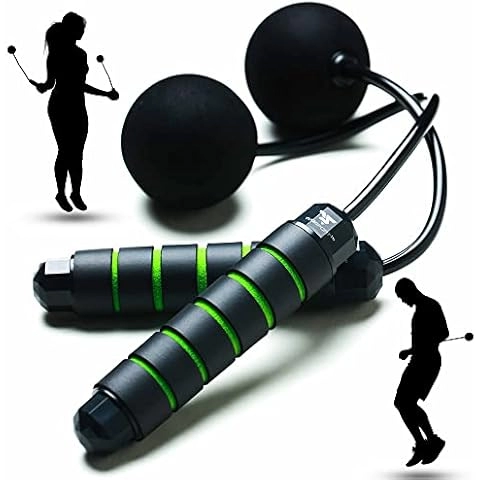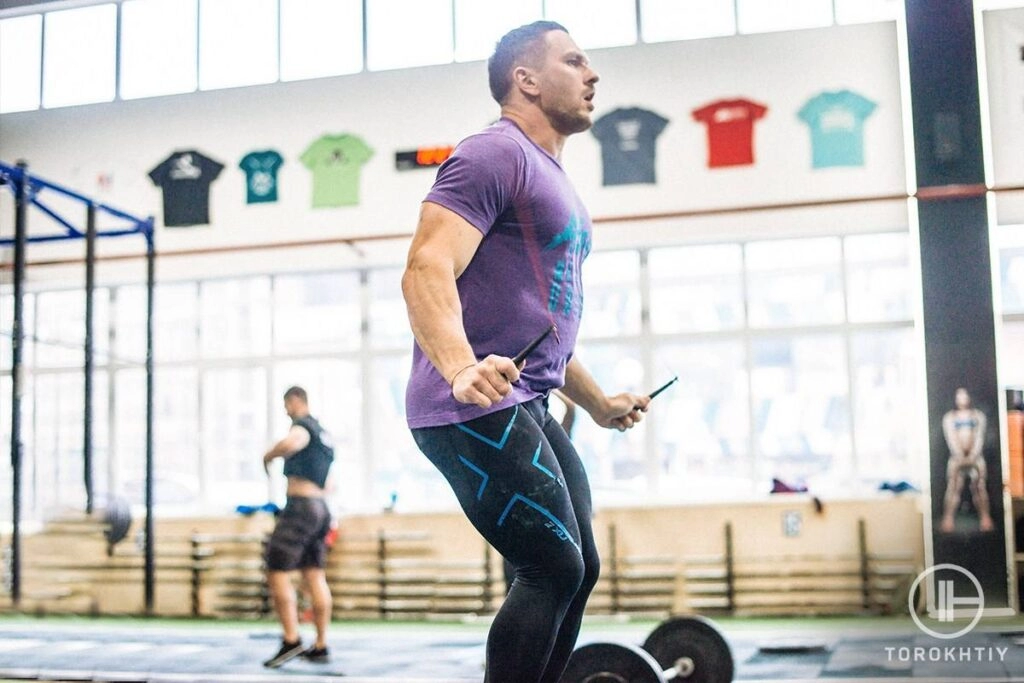Are you wondering if ropeless jump ropes are effective for your fitness goals? With so many workout tools out there, it’s tough to know if a cordless jump rope delivers the same punch as a traditional one. At PVCJumpRope.com, we’ve spent years perfecting high-quality jump ropes, and we’re here to break down the truth about ropeless jump ropes. In this guide, you’ll discover how they work, their benefits, and whether they’re the right fit for your cardio workout or fitness routine. Let’s jump in and explore!
What Are Ropeless Jump Ropes
Ropeless jump ropes, also known as cordless jump ropes or wireless jump ropes, are fitness tools designed to mimic traditional jump rope exercises without the need for an actual rope. Instead of a long rope circling under your feet, these devices rely on a pair of handles connected to short, weighted cords or even no cords at all, allowing users to perform the jumping motion freely. This design eliminates tripping hazards, making them a popular alternative for indoor workouts and compact spaces.
Design Differences Compared to Traditional Jump Ropes
Unlike traditional jump ropes — typically made from PVC, leather, or beaded materials with a continuous cable — ropeless jump ropes focus on mobility and safety. The handles often feature weighted ends or small rotating balls attached by a short cord, simulating the momentum of a regular rope. Some cordless designs eliminate the rope entirely, relying on hand and wrist rotation to replicate jump rope movements.
These differences translate into:
- No rope tangling or striking the floor
- Reduced space requirements
- Potentially lower risk of injury from tripping
Types of Ropeless Jump Ropes
There are two main categories of cordless jump ropes:
- Weighted Wireless Handles: These come with short cords or balls at each handle end weighted to simulate the feeling of a rope’s swing, offering some resistance for a more robust workout.
- Completely Rope-Free Devices: These use just the handles without any cords, relying on wrist rotation and jumping for cardio exercise. They’re ultra-compact and easy to store or travel with.
Intended Users and Typical Scenarios
Ropeless jump ropes are ideal for:
- Beginners learning basic jump rope timing without worrying about rope tangles or missteps.
- People with limited workout space, such as small apartments or offices, where swinging a full rope isn’t practical.
- Rehabilitation or older adults who need a low-impact form of cardio with minimal risk of falls.
- Workout enthusiasts seeking a convenient alternative or supplement to traditional jump ropes when traveling or during quick indoor sessions.
As a trusted PVC jump rope manufacturer, we recognize ropeless jump ropes fill an important niche but differ significantly in design and use from our high-performance traditional jump ropes, which remain essential for serious jump rope training. For those interested in traditional options with durable and customizable features, exploring our full range like the 6mm PVC jump rope is a great next step.
Evaluating the Effectiveness of Ropeless Jump Ropes for Cardio and Coordination

When it comes to ropeless jump ropes, fitness benefits like cardio improvement, coordination, and endurance are often the main focus. These cordless and wireless jump ropes with weighted handles provide a low-impact cardio workout that can get your heart rate up without the risk of tripping on a rope. This makes them a smart choice for people in small spaces or those new to jump rope workouts.
Cardio Benefits and Calorie Burn
Ropeless jump ropes still offer solid cardiovascular benefits. You can expect a good calorie burn, but it usually falls short when compared directly to traditional jump ropes. While the burn rate depends on your intensity and workout length, traditional ropes tend to engage more muscles because you’re constantly swinging and timing the actual rope. Ropeless versions focus more on mimicking the jump motion without the rope, which means less full-body muscle activation.
Coordination Timing and Technique Impact
Jump rope technique development is where ropeless jump ropes show some limitations. With no rope to time or avoid, you might miss out on improving key skills like rhythm, timing, and hand-eye coordination that come naturally with traditional jump ropes. This can affect jump rope skill progression, especially if you aim to perform advanced moves or tricks. However, for beginners, ropeless jump ropes provide a safer space to develop basic jumping timing and balance.
Muscle Engagement Differences
Traditional jump ropes engage your core, shoulders, forearms, and calves because of the continuous rope rotation effort. In contrast, ropeless jump ropes primarily target your lower body and cardio system. The weighted handles add resistance to arm muscles, but overall, you may see less muscle activation in the upper body. This can mean a less comprehensive full-body workout, although it’s still effective for endurance building and light strength training.
In short:
- Ropeless jump ropes offer effective cardio and endurance training with fewer tripping risks.
- They deliver a lower calorie burn compared to traditional ropes, especially for intense sessions.
- Technique and timing skills are less challenged without the rope, potentially slowing advanced skill gains.
- Muscle engagement focuses more on legs and core, with limited upper body work compared to wired ropes.
For many U.S. users, especially those in apartments or needing a low-impact option, ropeless jump ropes are a solid alternative but may fall short for serious jump rope athletes aiming for complete skill and strength development.
Pros and Cons of Ropeless Jump Ropes for Effective Cardio Workouts
When considering are ropeless jump ropes effective, it’s important to weigh their pros and cons in real workout scenarios. These jump rope alternatives come with benefits and limitations that impact your fitness routine.
Pros of Ropeless Jump Ropes
- No tripping risk: Without a rope swinging under your feet, you avoid tripping, making it much safer in tight or cluttered spaces.
- Compact and portable: These cordless jump ropes are small and easy to store, perfect for people with limited room who still want a solid cardio workout.
- Beginner friendly: They help new users get comfortable with jump timing and rhythm without worrying about catching the rope.
- Great for small spaces: Ideal for apartments, hotel rooms, or crowded gyms where a traditional jump rope might be impractical.
Cons of Ropeless Jump Ropes
- Less realistic rope feel: The lack of an actual rope means you miss out on the tactile feedback that helps with rhythm and technique.
- Limited skill development: Advanced jump rope tricks and double-unders are tough or impossible to perform, making rope-less options less effective for serious jump ropers.
- Not optimal for high-intensity training: Since you’re not swinging a real rope, muscle engagement—especially in the wrists and forearms—is reduced.
- Potential cost and durability concerns: Some wireless ropes with smart features or weighted handles come at a higher price and may require battery replacements or more cautious handling.
Practical Considerations
- Cost depends on features: Basic ropeless ropes are affordable but models with weighted handles or digital counters cost more.
- Durability varies widely: Plastic or rubber components might wear out faster compared to a quality PVC jump rope, which offers long-lasting performance.
- Limited accessories: Unlike traditional ropes where you can swap cables or adjust length easily, cordless models often come as-is with minimal modification options.
In short, ropeless jump ropes serve well as cordless jump rope benefits for beginners or those needing a compact workout equipment solution but fall short for users seeking serious skill progress or authentic rope feel. For more insight on jump rope options and skill training, check out our guide on how to jump rope like a boxer.
Who Should Consider Ropeless Jump Ropes for Effective Cardio Workouts
Ropeless jump ropes are best suited for specific groups of users and workout scenarios. If you’re a beginner or have limited space, these jump rope alternatives offer a simple and safe way to get started without worrying about tripping or needing a lot of room. Their compact design makes them ideal for apartments, offices, or small home gyms where swinging a traditional rope isn’t practical.
Beginners and Small Space Users
For those new to jump roping, ropeless jump ropes reduce the frustration of coordination and timing that often comes with a traditional rope. Without the risk of catching your feet, you can focus on building basic rhythm and endurance. If you live in a tight space, cordless jump ropes are also a great choice because they don’t require much room to use.
Injury Rehabilitation and Elderly Users
Ropeless jump ropes provide low-impact cardio workouts that are gentler on the joints compared to regular ropes. This makes them useful for injury rehabilitation or older adults who want to stay active without stressing knees and ankles. The weighted handles also help maintain upper body strength without the impact of jumping over a rope.
People Looking for Low Impact and Fun Alternatives
If you’re interested in a fun, low-impact alternative to traditional jump ropes, ropeless models deliver cardio benefits with less strain and more convenience. They help keep your heart rate up while minimizing the risk of injury and fatigue, adding variety to your workout routine.
For those ready to transition to a traditional jump rope, learning proper length and technique is important, and resources like how long should a jump rope be can help. Whether you stick to ropeless jump ropes or graduate to classic ones, choosing the right tool depends on your fitness goals and space.
Traditional Jump Ropes vs Ropeless Jump Ropes What PVCJumpRopecom Recommends
When it comes to traditional jump ropes versus ropeless jump ropes, PVCJumpRope.com firmly supports the traditional option for most fitness enthusiasts. While cordless jump ropes offer some convenience, traditional jump ropes—especially those made with quality PVC materials—deliver a workout experience that’s hard to match.
Why Traditional PVC Jump Ropes Remain the Gold Standard
Traditional jump ropes are still the go-to for anyone serious about improving their jump rope technique, endurance, and calorie burn. Unlike ropeless jump ropes, they require precise timing and rhythm, which helps develop better coordination and agility. The tactile feedback from the rope hitting the ground or your hands improves timing and makes the workout feel more natural.
With traditional ropes, you get:
- Full-body engagement that better recruits muscles in your arms, shoulders, and calves
- More intense cardio workouts due to continuous rope rotation
- Improved jump rope safety through developing control and footwork skills needed to avoid tripping
How PVC Materials Enhance Performance and Durability
Our PVC jump ropes stand out because the material is lightweight, durable, and flexible, making them ideal for users of all levels. PVC ropes glide smoothly through the air, allowing faster rotations and more consistent swings, which are key for high-intensity workouts.
Benefits of PVC jump ropes include:
- Increased rope speed for advanced drills and double unders
- Resistance to wear and tear for longer-lasting use
- Comfortable, ergonomic handles designed for grip and reduced hand fatigue
Recommendations from PVCJumpRopecom
- For beginners or those with limited space, ropeless jump ropes can be a good starting point.
- However, for fitness enthusiasts aiming for skill advancement, weight loss, and serious cardio, traditional PVC jump ropes are the better investment.
- Consider switching to a PVC jump rope once you’ve mastered the basics to gain the full benefits of jump rope training.
while ropeless jump ropes serve as fun and convenient jump rope alternatives, traditional PVC jump ropes provide a superior workout, better skill development, and longer-term value for users in the US market looking for effective cardio and fitness equipment.
Tips for Maximizing Your Workout with Any Jump Rope
Whether you’re using a ropeless jump rope or a traditional one, the key to getting the most from your workout lies in how you use it. Here’s how you can boost your sessions and make every jump count.
Proper Jumping Form and Timing
- Keep your elbows close to your sides and use your wrists to turn the rope instead of your whole arms. This saves energy and improves control.
- Jump on the balls of your feet, not your heels, to reduce impact and improve balance.
- Maintain a straight posture: Look forward, keep your core engaged, and avoid leaning too far forward or back.
- Stay light and quick with your jumps to build better cardio endurance and coordination.
- If you’re using a ropeless jump rope, focus on mimicking the rope swing rhythm even without the real rope for better timing and muscle memory.
Combining Jump Rope Exercises with Other Fitness Routines
Jump rope workouts are great on their own but can be even more effective when part of a broader fitness plan:
- Pair jump rope cardio bursts with strength training exercises like squats, lunges, or push-ups for a full-body workout.
- Add jump rope intervals to your HIIT routines for fast calorie burn and endurance building.
- Use ropeless jump ropes for compact warm-ups or quick cardio breaks in tight spaces.
- Mix traditional jump rope sessions outdoors or at the gym for technique practice and higher impact workouts.
When to Switch from Ropeless to Traditional Jump Ropes for Fitness Progression
Ropeless jump ropes are great starters or space-savers, but as your skills improve, moving to a traditional jump rope offers clear benefits:
- Switch when you’re comfortable with timing and coordination. Traditional ropes help refine your technique and improve footwork.
- If your goal is to burn more calories and increase workout intensity, a real rope demands more from your muscles and mind.
- Once you’re past basic cardio or rehab phases, transitioning to a traditional rope helps build greater endurance and advanced skills like double-unders.
- Traditional jump ropes—especially those made from durable PVC materials—offer better feedback, allowing you to push fitness limits safely.
By mastering form, blending workouts, and knowing when to upgrade your gear, you’ll maximize every jump rope session. Whether cordless or traditional, the right approach keeps your workouts effective and enjoyable.



